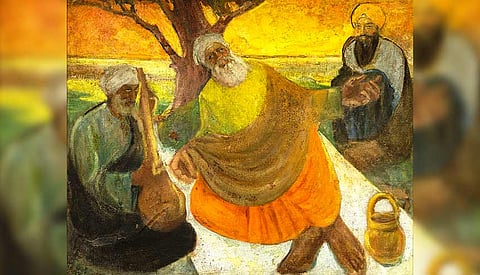

A miraculously recovered pre-Partition?painting of Guru Nanak by renowned Indian artist Sardari Lal Parasher has been added on to the ongoing online art exhibition-cum-fundraiser, 'Memories Unlocked:?Partition, Migration, Identity',organised by the Partition Museum in India to coincide with Partition Remembrance in the month of August.
The museum said the painting (pictured), a luminous oil on canvas painted in 1939-40, was thought to have been lost during the?Partition but was fortuitously rescued and has now been generously included in the exhibition by the Parasher family.
Named 'Guru Nanak, Continuous Light', the canvas depicts the founder of the Sikh faith on his journeys, seated in a field. He appears to be resting, yet reaching out to the world, while his two disciples, Bhai Mardana and Bhai Bala, are by his side. Bhai Mardana is seen playing the Rabab, with the scenery composed in glowing colours reminiscent of Punjab's rich golden mustard fields.
Mallika Ahluwalia, CEO and Curator of the?Partition?Museum, Founder Trustee of the Arts and Cultural Heritage Trust, said: “Work of this archival nature is not seen any more as most of the early work by many of Punjab's artists was either lost or scattered due to the?Partition.We hope that through this exhibition, more and more people will come to know about S.L. Parasher's work and artistic legacy.”
The museum reflects on the painting itself having a miraculous history. It is closely linked to the turmoil that took place during the?Partition and was almost lost - along with many other works of the well-known artist S. L. Parasher, who was then the Vice-Principal of the Mayo College of Art in Lahore. Parasher had to leave Lahore overnight post?Partition, and many of his pre-Partition?works were lost.
However,'Guru Nanak, Continuous Light'?was saved due to the friendship between him and another famous artist, Abdur Rahman Chughtai, who managed to rescue this painting and some of Parasher's other works from the chaos of?Partition and sent them across the border from the newly-created Pakistan to India.
The artworks safely reached the Government School of Art in Chandigarh, where they stayed locked up in storage for a decade before they were handed over to the Parasher family in Delhi. Now this painting has been given by the Parasher family to be included in the Partition Museum exhibition-cum-fundraiser.
Parasher's daughter, Dr Prajna Parasher, said about the painting: “In this depiction of 'Guru Nanak, Continuous Light', the artist's radiant subject assesses the viewer.Wise and silent, framed by a golden sunset and his own tired feet, it seems now he is seeing out of this moment of repose into the chaos that is about to come.But that is a retrospective gaze.
“Cameo or warning? How can one be sure? What is certain is that Guru Nanak and his disciples, Mardana and Bala, sit comfortably under the tree, themselves narrators of history, narrating outward to us here.”
At the time of?Partition, Parasher and his family migrated to India where he became the Founder Principal of the School of Art, Simla, and later the Director of the All India Handicrafts Board. After having lived in Lahore, Simla, Madras, and Bombay, Parasher finally made a permanent home in New Delhi.
His prolific line drawings from this time depicting the pain and suffering experienced by refugees are extremely powerful. Some of these are on display at the?Partition?Museum, Amritsar.
Sunaina Anand, Director of Art Alive Gallery, curator of the exhibition, and Trustee of The Arts and Cultural Heritage Trust said: “We are delighted to have such a rare work of S.L. Parasher,'Guru Nanak, Continuous Light' as a part of this ongoing exhibition.
“The artist's priceless legacy is captured in the versatile nature of his work which often stems from his experience of the?Partition. A precious work such as this has immense nostalgic value and is indeed a treasured resource for understanding the artist's heritage.”